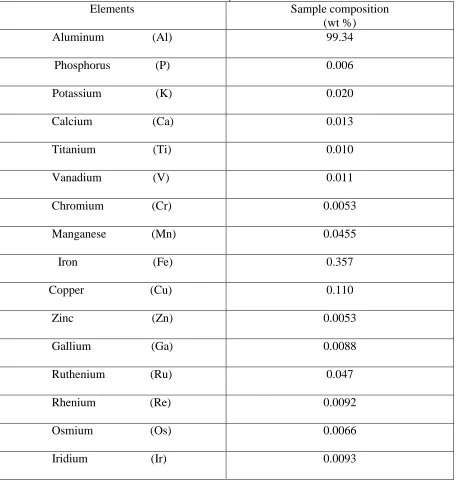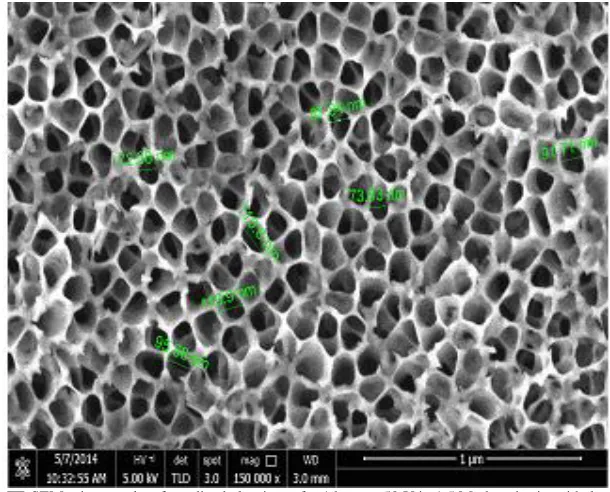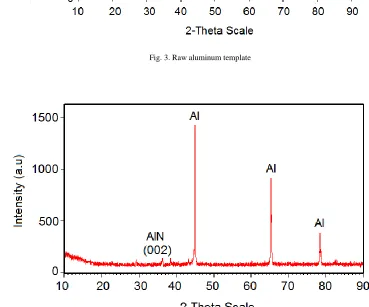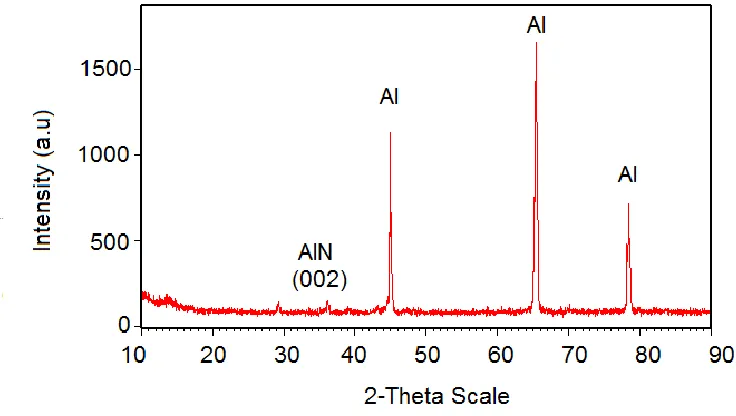A Novel Approach in the Fabrication of Aluminum
Nitride Layer from Nanoporous Alumina Template
Alaba .O. Araoyinbo
a*, Azwan Iskandar Azmi
a, Che Mohd Ruzaidi Ghazali
a, Azmi Rahmat
b, Kamarudin Hussain
a,
Mohd Mustafa Albakri Abdullah
a.
a) Faculty of Engineering technology, Department of Mechanical Engineering Technology, Universiti Malaysia Perlis,
UniCity Alam, Sungai Chucho, Padang Besar, Perlis Malaysia
b) School of Materials Engineering, Universiti Malaysia Perlis, Taman Muhibbah,
01000 Kangar, Perlis Malaysia.
*Email: alaba@unimap.edu.my; aoalaba@yahoo.com
Abstract-- A new approach has been developed to produce AlN layer from nanoporous alumina template by direct nitridation of anodic aluminum oxide (AAO) at a low temperature of 450 oC. The AAO template was fabricated in a phosphoric acid electrolyte with a controlled voltage of 50 V at room temperature to produce nano pore sizes of about 75 nm. The SEM shows the surface morphology of the template with the random distribution of the ordered nano pores. While the XRD results show the presence of AlN during the nitridation reaction with the porous alumina surface layer and aluminum base. This process is highly economical and allows the incorporation of a porous oxide surface and an aluminum nitride base.
Index Term-- AlN; Anodization; Electrolyte; Heat treatment; Nanoporous; Nitridation.
1. INTRODUCTION
There has been a lot of attention on nanostructured materials that could find use in a wide range of areas that includes electronics, dielectrics, and photonics [1-3]. Aluminum nitride because of its unique physical and chemical properties that includes low dielectric constant, high thermal conductivity, good wear resistance and wide band gap of 6.2 eV at room temperature have further generated the research interest on its potential application [4-8].
AlN films have been synthesize through chemical vapor deposition, magnetron sputtering, and direct nitridation [9-13]. The sputtering technique which is an expensive process with a low deposition rate can be replaced with the use of a porous template which is less expensive and allows the synthesis of any compounds or material on its surface.
This present study shows a new approach in the nitridation of a nanoporous aluminum template. The sole aim of this method is to be able to incorporate aluminum nitride base and a porous alumina surface due to the interesting properties and vast applications both could find use for. The nanoporous alumina template was fabricated under a well-controlled electrochemical cell condition at room temperature to allow
of nitrogen gas in a controlled environment to allow the formation of aluminum nitride.
2. EXPERIMENTAL
2.1 Preparation of the Aluminum Foil
Aluminum template with a fixed dimension of 30 mm X 10 mm and thickness of 0.25 mm were cut from the aluminum sheet. The chemical composition of the received raw material was characterized with XRF (GNR OPTICA-QUALITA X) using 2.7 cm cut dimension and the composition shown in Table 1. The templates were cleaned with acetone in Dentec ultrasonic cleaner to remove any possible oil or sticky stains on its surface [14,15]. The electrochemical polishing of the aluminum templates were performed in a 1:4 volume mixture
of HClO4 and C2H5OH at constant current density of 300
mAcm−2 for few seconds at a low temperature [16]. The
templates were then rinsed with distilled water and dried with an air gun. The electrolyte used for the anodization process is phosphoric acid which is suitable for room temperature
fabrication of nanoporous alumina. The electrolye
concentration used is 1.5 M (H3PO4) aqueous solution and the
applied potential for the anodization process is 50 V to produce medium size nano pores [17].
The prepared templates were anodized in a single-walled electrochemical cell using platinum electrode as the cathode electrode and the aluminum templates as the anode electrode. The distance between the two electrodes was kept at 2.5 cm to enable fast and easy movement of the ions.
For the direct nitridation process, the fabricated nanoporous aluminum template is placed in a flat rectangular ceramic plate of 60 mm X 15 mm and put in a tube furnace heated to a
temperature of 450 oC with a constant heating rate of 3 oC/min
and soaking time of up to 5 hrs. During the heating process, nitrogen was passed into the furnace at a flow rate of 0.6 l/min
and allowed to cool to below 150 oC overnight [18,19].
International Journal of Engineering & Technology IJET-IJENS Vol:16 No:02 17
Table I
Chemical composition of raw material
Elements
Sample composition
(wt %)
Aluminum (Al)
99.34
Phosphorus (P)
0.006
Potassium (K)
0.020
Calcium (Ca)
0.013
Titanium (Ti)
0.010
Vanadium (V)
0.011
Chromium (Cr)
0.0053
Manganese (Mn)
0.0455
Iron (Fe)
0.357
Copper (Cu)
0.110
Zinc (Zn)
0.0053
Gallium (Ga)
0.0088
Ruthenium (Ru)
0.047
Rhenium (Re)
0.0092
Osmium (Os)
0.0066
Iridium (Ir)
0.0093
3. RESULTS AND DISCUSSION
Figure 1 shows the FE-SEM of nanoporous alumina fabricated at room temperature in 1.5 M phosphoric acid electrolyte. The pores were observed to be randomely distributed on the surface of the template. The current generated during the anodization from a 50 V potential was between 70 – 100 mA to produce an average pore size of 75 nm. The size of the pores produced is comparable to what others have reported
using low freezing temperature. There have also been a report that confirms the relationship between the applied voltage, time and the sizes of pores to be linear, and the higher the voltage the wider the pore size [16] until an optimum anodizing time is reached when no further increase in pore sizes is possible [20]. At a higher voltage the reaction proceeds at a much faster rate and the penetration of the
Fig. 1. FE-SEM micrographs of anodized aluminum for 1 hour at 50 V in 1.5 M phosphoric acid electrolyte
The nitridation process involving the use of the anodic aluminum oxide (AAO) template is illustrated in Figure 2. The aluminum template was anodized to produce a porous surface that was subjected to further heat treatment and the direct flow
of nitrogen gas into the tube furnace for the N2 gas to react
with the aluminum base thereby producing AlN. The heating environment was controlled to reduce the effect of oxygen and to allow the reaction between the aluminium base and the gas supplied into the tube furnace [21].
Fig. 2. Anodization and nitridation process (a) aluminium template with 0.25 mm thickness; (b) initial anodization process to produce the AAO barrier layer; (c) prolong anodization leads to pore formation; (d) direct nitridation process with nitrogen gas flow at 450 oC; (e) formation of aluminium nitride layer below the
porous oxide surface. Figure 3 shows the X-ray diffraction patterns of unanodized
aluminum template. The patterns from the XRD shows the
FCC structure of the aluminum foil with peaks at 39o and 45o
on the 2θ scale corresponding to diffractions from (111) and (200) planes with low intensities (ICDD 004-0787). While
high intensity peaks are observed at 65o and 78o on the 2θ
scale corresponding to diffractions of (220) and (311) planes
International Journal of Engineering & Technology IJET-IJENS Vol:16 No:02 19
Fig. 3. Raw aluminum template
Fig. 5. XRD of nanoporous alumina template with direct nitridation with N2 gas at 450 oC. 4. CONCLUSION
For the first time AlN was successfully produced at low heating temperature using a nanoporous alumina template. When compared with AlN produced from pure aluminium under the same condition, a similar sharp peak was observed and the AAO has a slightly broader peak. The formation of AlN base and porous alumina surface could provide a useful application where any desired compound could be synthesized at the surface.
A
CKNOWLEDGEMENTThis work was supported by Faculty of Engineering Technology, through Department of Mechanical Engineering Technology, Universiti Malaysia Perlis.
REFERENCES
(1) W. Hue-Min, P. Yi-Wen, Ceramic International 41 (2015) 4847. (2) L. Duta, G.E. Stan, H. Stroescu, M. Gartner, M. Anastasescu, Z.
Fogarassy, N. Mihailescu, A. Szekeres, S. Bakalova, I.N.
Mihailescu, Applied Surface Science
http://dx.doi.org/10.1016/j.apsusc.2015.10.093. (3) F. Chris, W.S. Lim, Thin Solid Films 589 (2015) 338.
(4) B. Yingbin, L. Moning, K. Genshui, C. Yigang, D. Jim, C. Eason, Y. Yimou, Surface and Coatings Technology 267 (2015) 65. (5) Y. Huaiyu, S. Koh, H. Van Zeijl, A.W.J. Gielen, Z. Guoqi, Journal
of Semiconductors 32 (2011) 1.
(6) Q. Liang, C. Shuwen, Z. Jingwu, J. Liqiang, C. Shenglei, C. Advanced Powder Technology26 (2015) 830.
(7) S. Shanmugan, D. Mutharasu, A.H. Haslan, International Journal of Electronics and Computer Science Engineering 2 (2012) 296. (8) C. Duquenne, M.P. Besland, P.Y. Tessier, E. Gautron, Y.
Scudeller, D. Averty, Journal of Applied Physics 45 (2012) 015301.
(9) R.K. Choudhary, A. Soni, P. Mishra, D.R. Mishra, M.S. Kulkarni, Journal of Luminescence 155 (2014) 32.
(12) M. Schneider, A. Bittner, A. Klein, U. Schmid, Microelectronic Engineering 140 (2015) 47.
(13) J. Legrand, P. Pigeat, T. Easwarakhanthan, H. Rinnert, Applied Surface Science 307 (2014) 189.
(14) M.A. Kashi, A. Ramazani, M. Raoufi, A. Karimzadeh, Thin Solid Films 518 (2010) 6767.
(15) D.S. Grzegorz, J.S. Wojciech, Electrochimica Acta 54 (2009) 3683.
(16) A. Ghafar, A. Maqsood, I.A. Javed, M. Muhammad, O.C. Sung, Micron 41 (2010) 560.
(17) A.O. Araoyinbo, A. Rahmat, M.N. Derman, K.F. Ahmad, Advanced Materials Letters 4 (2013) 899.
(18) Q. Yu, G. Lian, Journal of the European Ceramic Society 23 (2003) 2015.
(19) D. Kent, G.B. Schaffer, T.B. Sercombe, J. Drennan, Scripta Materialia 54 (2006) 2125.
(20) K. Nielsch, J. Choi, K. Schwirn, R.B. Wehrspohn, U. Gosele, Nano Letters 2 (2002) 677.



